Deciphering The Importance Of Your Automobile'S Caution Indicators
Deciphering The Importance Of Your Automobile'S Caution Indicators
Blog Article
Web Content Composed By-McKee Boyer
When you lag the wheel, those radiant caution lights on your control panel can be a little bit complicated. Do you know what they're attempting to tell you about your cars and truck's health and wellness? Understanding the value of these lights is important for your safety and the long life of your car. So, the following time one of those lights appears, would not you wish to decode its message accurately and take the required actions to address it?
Common Caution Lighting and Interpretations
Identify usual warning lights in your car and comprehend their definitions to ensure safe driving.
The most typical caution lights include the check engine light, which signals problems with the engine or discharges system. If this light begins, it's important to have your automobile checked quickly.
The oil stress cautioning light indicates reduced oil stress, calling for prompt focus to prevent engine damage.
German car specialists blinking battery light could recommend a defective billing system, possibly leaving you stranded if not dealt with.
The tire pressure tracking system (TPMS) light informs you to reduced tire pressure, impacting vehicle security and gas performance. Neglecting this can cause harmful driving conditions.
The abdominal muscle light indicates a problem with the anti-lock braking system, compromising your ability to stop promptly in emergency situations.
Finally, the coolant temperature warning light warns of engine overheating, which can result in serious damage otherwise settled swiftly.
Comprehending these typical caution lights will help you attend to issues without delay and maintain risk-free driving conditions.
Relevance of Prompt Interest
Recognizing the usual caution lights in your vehicle is only the first step; the significance of quickly addressing these cautions can not be stressed enough to guarantee your safety when driving.
When a caution light brightens on your control panel, it's your cars and truck's method of communicating a possible issue that needs focus. Overlooking these cautions can cause extra extreme issues in the future, endangering your security and potentially costing you a lot more out of commission.
Prompt interest to alerting lights can protect against failures and crashes. For example, a blinking check engine light might show a misfire that, if left neglected, could cause damages to the catalytic converter. Resolving this quickly can save you from a costly repair service.
Similarly, a brake system cautioning light could indicate reduced brake liquid or worn brake pads, vital parts for your security when driving.
Do It Yourself Troubleshooting Tips
If you notice a caution light on your dashboard, there are a couple of do it yourself repairing ideas you can try before looking for specialist assistance.
The primary step is to consult your vehicle's manual to recognize what the specific warning light indicates. In some cases the concern can be as simple as a loose gas cap setting off the check engine light. Tightening up the gas cap might deal with the problem.
One more common problem is a low battery, which can set off numerous warning lights. Checking the battery connections for deterioration and guaranteeing they're safe could deal with the trouble.
If a caution light continues, you can try resetting it by disconnecting the automobile's battery for a few mins and then reconnecting it. Additionally, inspecting your automobile's fluid degrees, such as oil, coolant, and brake liquid, can aid troubleshoot cautioning lights connected to these systems.
Conclusion
Finally, comprehending your auto's warning lights is essential for keeping your vehicle running smoothly and safely. By without delay attending to these notifies and understanding what they indicate, you can stay clear of costly fixings and possible failures.
Suggested Reading in mind to consult your cars and truck's guidebook for certain information on each cautioning light and take action appropriately to ensure a trouble-free driving experience.
Stay informed, remain risk-free on the road!
